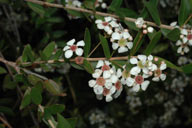In Flower This Week
A news sheet prepared by a Gardens' volunteer.
Numbers before each plant refer to temporary IFTW labels in the gardens.
Numbers in square brackets [ ] refer to garden bed Sections. Plants in flower are in bold type.
View past issues of 'In Flower This Week'.
6 January 2016
Sannantha pluriflora
click for larger image |
We will walk along the Main Path today starting at the Visitor Information Centre (VIC).
- On your right as you leave the VIC in a pot is Blandfordia grandiflora [Section 221], or Christmas Bells,with large fluted red bells tipped with yellow on thin stems above linear foliage. It is native to south-eastern Australia.
- Further along on the left, also in a pot, is Grevillea juncifolia [Section 210] with narrow grey bootlace-like leaves and long racemes of yellowish-white flowers. This grevillea grows in dry inland Australia.
- Cross the bridge and skirt past the café to see on your left Babingtonia ‘White Cascade’ [Section 131], a medium-sized bush with weeping foliage and masses of small white, 5-petalled flowers. This cultivar arose as a chance seedling at Wirreanda Nursery in Ingleside, New South Wales.
- Go up the hill and bear right. On your left is Sannantha pluriflora [Section 30], or Tall Baeckea, a tall shrub or small tree with dark green foliage and bright white flowers with green centres. It is found in the wild along the coasts of New South Wales and Victoria.
- On your right is Stenocarpus angustifolius [Section 30], a tall shrub with clusters of lemon flowers in attractive contrast to the lance-shaped light green foliage. It is found in the wild in coastal Queensland.
- On your left is Grevillea obliquistigma subsp. funicularis [Section 30], with light green linear foliage and cream flowers. This plant occurs naturally between Geraldton and Perth in Western Australia.
- On your right Grevillea ‘Coconut Ice’ [Section 25] has large pink/orange spider flowers with long red styles. It is has a hybrid origin, being grown from seed collected from Grevillea bipinnatifida. The male parent was a white-flowered form of G. banksii. The seedling was raised by Mr. M. Hodge of Queensland.
- Cross the road to see on both your right and left Grevillea ‘LadyO’ [Sections 24 and 26] a long-blooming shrub with red flowers and bright green foliage. ‘LadyO’ originated from a cross between a Grevillea victoriae hybrid and Grevillea rhyolitica. The cultivar was selectedby local plant breeder Peter Ollerenshaw and named for his mother.
- On your right is Grevillea sericea [Section 26] with pink spider flowers on a long-flowering open bush. This plant is endemic to New South Wales.
- Further on your right Persoonia acerosa [Section 26], or Needle Geebung, has bright green foliage and yellow tubular flowers towards the tips of the branchlets. It occurs in central coastal New South Wales.
- Also on your right is Grevillea plurijuga subsp. plurijuga [Section 26], with fresh green upright foliage and long stems ending in purplish-pink flowers. It grows naturally near Esperance, Western Australia.
- On your right is Lambertia inermis [Section 26], or Noongar Chittick, which is endemic to south-west Western Australia. It is a tall shrub with green foliage and large orange “wagon wheel” flowers.
- Grevillea tripartita subsp. macrostylis [Section 24], on the left, is an open, rangy plant with dark green, prickly, three-lobed foliage and large single red and cream flowers with long showy red styles. It is native to southern Western Australia.
- On your right is Persoonia microphylla [Section 26], a low groundcover with tiny green foliage and small tubular gold flowers. The species occurs on the central and southern tablelands of New South Wales.
- On your left is Grevillea sericea subsp. sericea [Section 24], an airy bush with light green foliage and white spider flowers. This plant occurs naturally west of Sydney.
Rosalind Walcott
![Director of National Parks [logo]](../../../../images/dnp_90px.gif)







